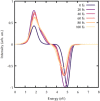Automatized protocol and interface to simulate QM/MM time-resolved transient absorption at TD-DFT level with COBRAMM
- PMID: 35815854
- PMCID: PMC9544370
- DOI: 10.1002/jcc.26966
Automatized protocol and interface to simulate QM/MM time-resolved transient absorption at TD-DFT level with COBRAMM
Abstract
We present a series of new implementations that we recently introduced in COBRAMM, the open-source academic software developed in our group. The goal of these implementations is to offer an automatized workflow and interface to simulate time-resolved transient absorption (TA) spectra of medium-to-big chromophore embedded in a complex environment. Therefore, the excited states absorption and the stimulated emission are simulated along nonadiabatic dynamics performed with trajectory surface hopping. The possibility of treating systems from medium to big size is given by the use of time-dependent density functional theory (TD-DFT) and the presence of the environment is taken into account employing a hybrid quantum mechanics/molecular mechanics (QM/MM) scheme. The full implementation includes a series of auxiliary scripts to properly setup the QM/MM system, the calculation of the wavefunction overlap along the dynamics for the propagation, the evaluation of the transition dipole moment at linear response TD-DFT level, and scripts to setup, run and analyze the TA from an ensemble of trajectories. Altogether, we believe that our implementation will open the door to the easily simulate the time-resolved TA of systems so far computationally inaccessible.
Keywords: QM/MM; TD-DFT; trajectory surface hopping; transient absorption; ultrafast spectroscopy.
© 2022 The Authors. Journal of Computational Chemistry published by Wiley Periodicals LLC.
Figures








Similar articles
-
INAQS, a Generic Interface for Nonadiabatic QM/MM Dynamics: Design, Implementation, and Validation for GROMACS/Q-CHEM simulations.J Chem Theory Comput. 2022 Aug 9;18(8):4601-4614. doi: 10.1021/acs.jctc.2c00204. Epub 2022 Jul 28. J Chem Theory Comput. 2022. PMID: 35901266
-
Reconciling TD-DFT and CASPT2 electronic structure methods for describing the photophysics of DNA.Photochem Photobiol. 2024 Mar-Apr;100(2):443-452. doi: 10.1111/php.13922. Epub 2024 Feb 14. Photochem Photobiol. 2024. PMID: 38356286
-
QM/MM Nonadiabatic Dynamics: the SHARC/COBRAMM Approach.J Chem Theory Comput. 2021 Aug 10;17(8):4639-4647. doi: 10.1021/acs.jctc.1c00318. Epub 2021 Jun 11. J Chem Theory Comput. 2021. PMID: 34114454
-
Molecular Simulations with in-deMon2k QM/MM, a Tutorial-Review.Molecules. 2019 Apr 26;24(9):1653. doi: 10.3390/molecules24091653. Molecules. 2019. PMID: 31035516 Free PMC article. Review.
-
Review on the QM/MM Methodologies and Their Application to Metalloproteins.Molecules. 2022 Apr 20;27(9):2660. doi: 10.3390/molecules27092660. Molecules. 2022. PMID: 35566011 Free PMC article. Review.
Cited by
-
Sub-100-fs energy transfer in coenzyme NADH is a coherent process assisted by a charge-transfer state.Nat Commun. 2024 Jun 8;15(1):4900. doi: 10.1038/s41467-024-48871-4. Nat Commun. 2024. PMID: 38851775 Free PMC article.
-
The OpenMolcas Web: A Community-Driven Approach to Advancing Computational Chemistry.J Chem Theory Comput. 2023 Oct 24;19(20):6933-6991. doi: 10.1021/acs.jctc.3c00182. Epub 2023 May 22. J Chem Theory Comput. 2023. PMID: 37216210 Free PMC article.
-
Non-Phenomenological Description of the Time-Resolved Emission in Solution with Quantum-Classical Vibronic Approaches-Application to Coumarin C153 in Methanol.Molecules. 2023 May 5;28(9):3910. doi: 10.3390/molecules28093910. Molecules. 2023. PMID: 37175320 Free PMC article.
-
Roadmap for Molecular Benchmarks in Nonadiabatic Dynamics.J Phys Chem A. 2025 Aug 7;129(31):7023-7050. doi: 10.1021/acs.jpca.5c02171. Epub 2025 Jul 15. J Phys Chem A. 2025. PMID: 40663750 Free PMC article. Review.
-
Nonadiabatic Molecular Dynamics Simulations Provide Evidence for Coexistence of Planar and Nonplanar Intramolecular Charge Transfer Structures in Fluorazene.J Phys Chem A. 2024 Aug 15;128(32):6685-6694. doi: 10.1021/acs.jpca.4c03693. Epub 2024 Aug 7. J Phys Chem A. 2024. PMID: 39109856 Free PMC article.
References
-
- Zewail A. H., J. Phys. Chem. A 2000, 104(24), 5660.
-
- Maiuri M., Garavelli M., Cerullo G., J. Am. Chem. Soc. 2020, 142(1), 3. - PubMed
-
- Polli D., Altoè P., Weingart O., Spillane K. M., Manzoni C., Brida D., Tomasello G., Orlandi G., Kukura P., Mathies R. A., Garavelli M., Cerullo G., Nature 2010, 467(7314), 440. - PubMed
-
- Kumpulainen T., Lang B., Rosspeintner A., Vauthey E., Chem. Rev. 2017, 117(16), 10826. - PubMed
-
- Woodhouse J., Nass Kovacs G., Coquelle N., Uriarte L. M., Adam V., Barends T. R. M., Byrdin M., de la Mora E., Bruce Doak R., Feliks M., Field M., Fieschi F., Guillon V., Jakobs S., Joti Y., Macheboeuf P., Motomura K., Nass K., Owada S., Roome C. M., Ruckebusch C., Schirò G., Shoeman R. L., Thepaut M., Togashi T., Tono K., Yabashi M., Cammarata M., Foucar L., Bourgeois D., Sliwa M., Colletier J.‐P., Schlichting I., Weik M., Nat. Commun. 2020, 11(1), 741. - PMC - PubMed
Publication types
MeSH terms
Grants and funding
LinkOut - more resources
Full Text Sources

